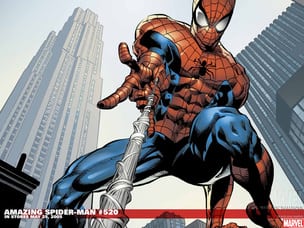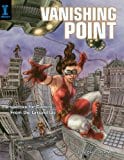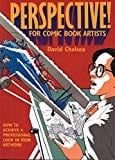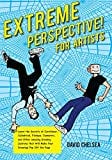Contents
Drawing perspective is very important for nearly every kind of art, and many people find it very hard to draw perspective shapes and distances. Every single comic book that has been created uses perspective in some way, and anyone who wants to become a comic book artist needs to learn how to draw perspective properly.
What is perspective?
Perspective is simply looking at a picture in the same way that you would look at live images. When you stand in one spot, certain objects that are closer to you appear to be larger than objects that are far away. It seems that the perspective around you seems to change as your eyes look at objects that are farther away, and drawing perspective is the effort of the comic book artist to capture that difference in size and shape of objects near and far away.
There are many types of perspective, and each has its own steps to drawing properly:
Vanishing Point
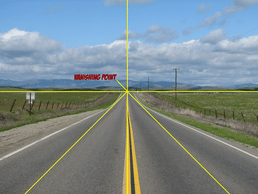
The vanishing point is the point that is as far as your eyes can see. At some point lines to the left or right of you appear to converge, and that is the vanishing point. Including the vanishing point in a picture is how comic book artists are able to convey the sense of extreme distance. The vanishing point is simply when the objects to the left and to the right of the viewer blend together into one single point, and is very important. When drawing perspective, use the converging point that represents the distance in the picture as the starting point for the lines that run to the left and right of your “eye” to provide the perspective.
Single Point
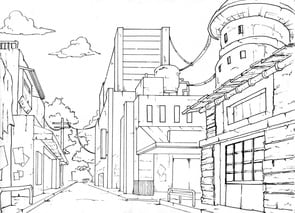
Single point perspective is when objects are vanishing into the distance in only one direction. This is usually drawn when the front of certain objects are facing the picture’s viewer, such as a line of skyscrapers running along a road disappearing into the distance. There is only one vanishing point in the distance on which the lines to the left and right of the viewer’s “eye” are converging. Single point perspective is the simplest form of perspective, and requires that you draw perspective only in one direction.
Basic Linear
Basic Linear Perspective is the perspective along which lines are drawn. There are many kinds of lines that you will use in drawing perspective, and it is important to know the use of each. Parallel lines are lines that are facing each other and are exactly alike, but they will never meet. A perpendicular line is a line that intersects with another line at a 90 degree angle. A vertical line is drawn in an up and down direction, while a horizontal line is drawn in a left to right direction. Vertical lines are perpendicular to the horizon lines, while horizontal lines are parallel to the horizon lines. A diagonal line is a line that runs diagonally and connects 2 vertices contained in a polygon. These lines tend to intersect both vertical and horizontal lines at varying angles, and they are commonly used in illustrating perspective.
Converging Lines
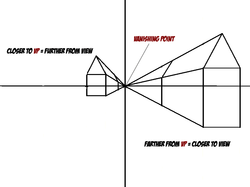
Converging lines are when two lines that are fading into the “distance” of the picture appear to be getting closer. While they don’t actually reach the vanishing point in the ultimate distance of the picture, they do converge closer and closer together to give the picture the appearance of things being more and more distant. The converging lines can be as close together or as far apart as you want. The farther apart the converging lines are, the shorter the distance you are trying to convey in the perspective of the picture will appear. The closer the converging lines are, the farther the distance is that you are portraying in the pictures.
Horizon Lines
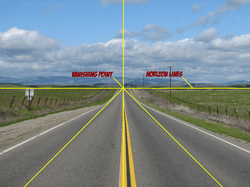
The horizon is the line on which the sky and the earth meet. These lines are a vital part of the perspective of the picture, as items begin to appear farther away as they get closer to the horizon line. The horizon line should be drawn at the beginning of the picture, as the horizon line is considered the eye level of the entire picture. Without the horizon line, the perspective of the picture would lack depth perception, meaning that there would be no way for the viewer to know when the ground ends and the sky begins.
Foreshortening
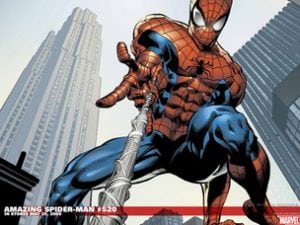
Foreshortening is a common effect that is found in realistic comic book art. Foreshortening is when objects appear to be compressed when viewed from a certain viewpoint or angle. For instance, when an object is seen from above, the base of the object appears to be smaller than the top of the object because the viewpoint from which you are seeing the object causes it to appear distorted. The same is used to convey distance in a picture, when one side of a building or object appears to be thinner or smaller than the closer side of the building because of the viewpoint. Foreshortening is usually drawn according to the converging lines that convey the distance of the picture, and the degree of foreshortening varies according to the perspective being conveyed in the picture.
These are a few techniques that can help you get started in drawing perspective, and by learning these different techniques you can begin to draw lifelike and realistic perspective in your pictures. It will take a good deal of practice to get it right, but by applying these techniques you will have the fundamental knowledge you need to begin drawing perspective.
Recommended Books
Vanishing Point: Perspective for Comics from the Ground Up by Jason Cheeseman-Meyer
Probably one of the very best books about perspective creation. Takes the reader from the initiation level to the most serious professional one by a series of step-by-step tutorials. It is a must for every comic illustrator, whether US realistic style, European (Belgian) “clear line” realistic or humoristic illustrator, or manga-style. The only point not covered by this manual is shadows but, on the other side, it covers non-orthoscopic (fish-eye) perspective with a lot of variations. It could also be more advanced about creating a perspective from an elevation map of the scene (so there is a small place left for other books, LOL). I heartily recommend this book.
Perspective! for Comic Book Artists: How to Achieve a Professional Look in your Artwork by David Chelsea
If you are interested about perspective and you are a total noob, read this book first, than once you reach the end if you are still interested go read a real perspective book.
But I do HIGHLY recommend this one if you are just starting out, but if you have already taken a perspective class or you just finished a 500pg classic on the subject… you whont be learning much here.
If you are new, and you are a visual learner, skip all other perspective books and read this one first.
Extreme Perspective! For Artists by David Chelsea
Understanding perspective is so important in art and so many artists don’t spend enough time learning how it works. This is an advanced look at perspective that breaks it down into understandable concepts. The fact that it is amusing and fully illustrated makes the learning process feel like reading a good story.
Submit your review | |

